
Unique in character and deportment is the Porsche; ever since the make’s introduction 10 years ago it has defied convention and proffered a quite individual form of motoring. Even experienced drivers who choose to buy one must take some pains to appreciate its qualities and abilities to the full; once the techniques have been mastered there are few cars indeed which provide such a satisfying and intriguing form of road travel.
It has been said of some rather dull but very well made cars that they represent a triumph of engineering over design; of the Porsche it might be said, not unkindly, that it has become a triumph of development over design. When first presented to the public it was not an altogether good car on the road; it called for more than average skill — even courage — to get the best out of it. Over the years, various modifications to the suspension and steering gear have given the car progressively more orthodox handling characteristics.
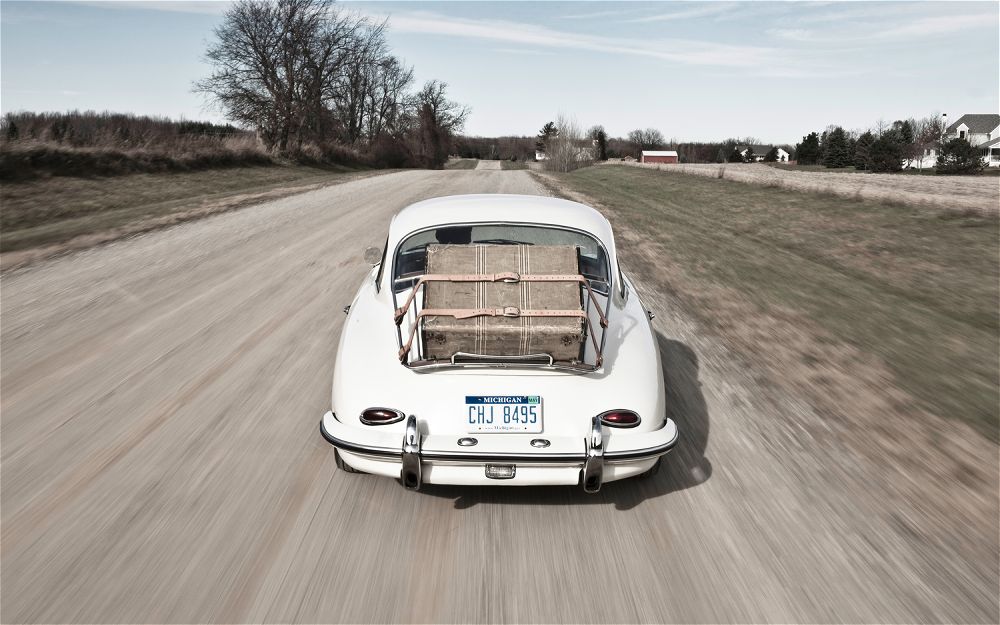
Low build and aerodynamically dean panelwork of the Porsche are important contributors to its remarkable performance. From their new, raised fairings, the head lamps provide much-improved efficiency.
As a result, behaviour of the Porsche 356 Super 75 recently tested was found noticeably more predictable than that of its predecessors, and it took a driver appreciably less time to become at ease with the new model after handling more humdrum machinery. Despite this concession to orthodoxy, the Porsche character remains almost as strongly defined as ever.
For 1960 the Porsche “face” was lifted — quite literally — by raising the head lamp fairings several inches, and bringing up the front and rear bumpers to match. Whether this has improved the look of the car is a matter of personal taste, and no concern of a road test. Certainly the new position of the Bosch head lamps (which satisfies legal requirements in all States of the U.S.A.) has greatly improved their combination of range and spread on main and dipped beams, to such an extent that they are now of outstanding efficiency, even by today’s generally high standards. Their settings can be adjusted without removing the rims.
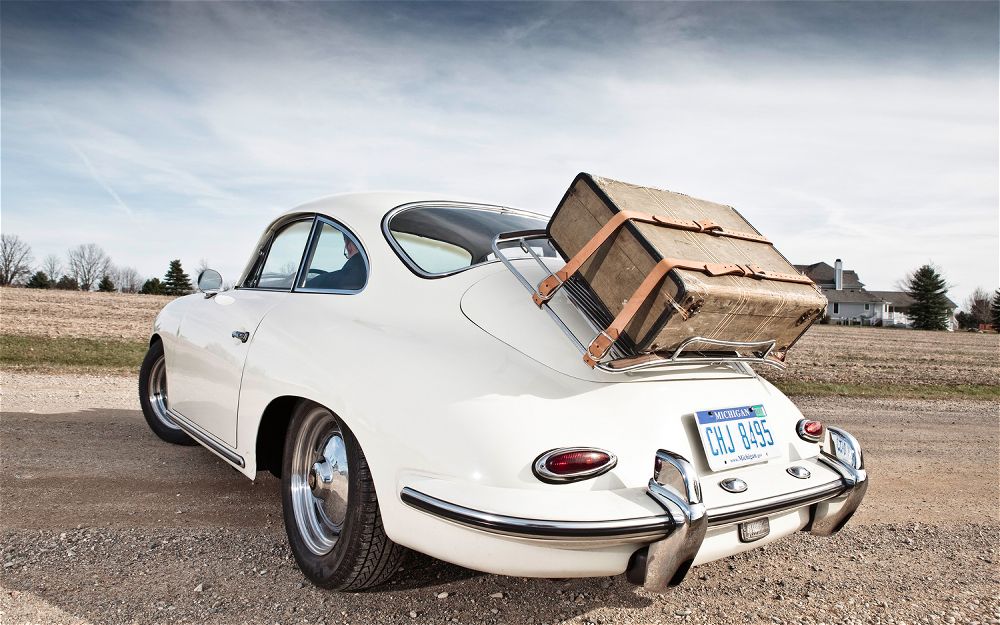
Although the back window is necessarily shallow, it is near enough to the driver to allow him a fuller view than might be expected. Swivelling panes in the door windows are new.
Perhaps the most interesting basic difference between the engines of the current Super models (75 and 90), as distinct from the present standard 1600 and superseded Super, is that they now have four separate cylinder barrels of light alloy, of which the bores are faced with hard chrome. These have the particular advantages of lightweight and quick heat dissipation. Net maximum power output of the Super 75 is 75 b.h.p., the gross figure (in test house conditions, without cooling fan and auxiliaries) being 88 b.h.p. While the Super’s highest torque figure of 88 lb. ft. is slightly greater than that of the standard 1600, it is achieved at considerably higher r.p.m. — 3,700 instead of 2,800 — so that one cannot expect quite the same tractability at low crankshaft speeds.
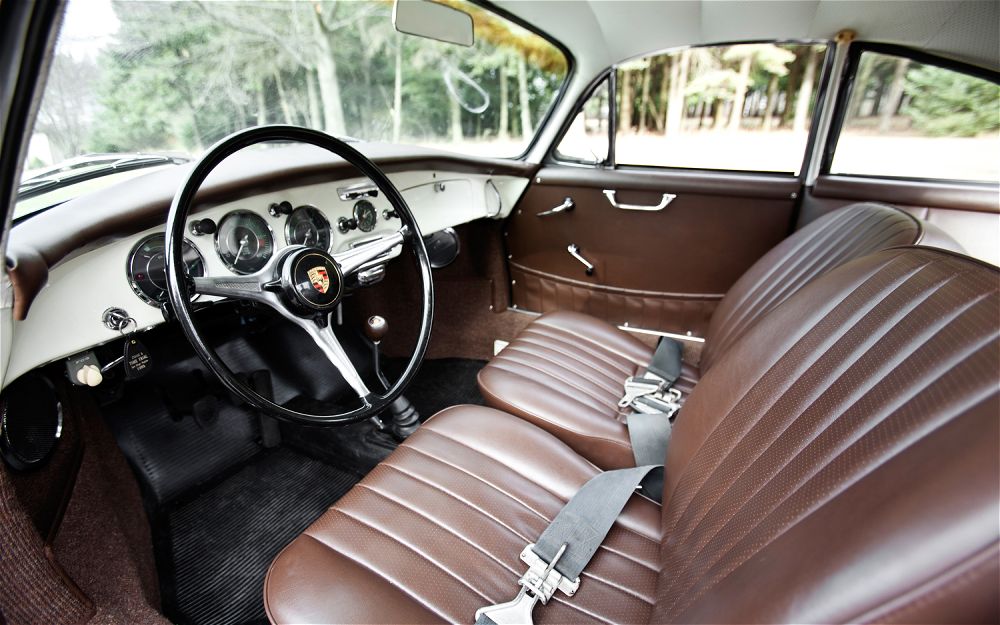
In the back are two seats for children — or for one adult sitting sideways with head bowed. Their backrests can be folded forward to form a luggage platform. New for 1960 are the dished steering-wheel and cranked gear lever. The accessible fuel filter bowl which can be seen below the facia does not obstruct the driver’s legs, as might appear. There are full-length mop pockets in the doors, and a locker in the facia.
Any 1,600 c.c. coupe which can accelerate from a standstill to 90 m.p.h. in appreciably under 30 sec (28.8 to be exact) and reach a mean maximum approaching 110 m.p.h. must be considered a sports car; yet in many respects this Porsche has a Jekyll and Hyde character, being almost ideal day-to-day transport for two, in or out of town. It is completely docile, has light and precise controls, and is endowed with most of the creature comforts demanded of a strictly touring car these days. Moreover, there are no slapdash crudities to be found, either of components or their assembly. Doors, for instance, open and close with satisfying ease and quietness;, and are effectively sealed against dust, rain and draughts. Despite the car’s low build, they do not foul high kerbs when opened.
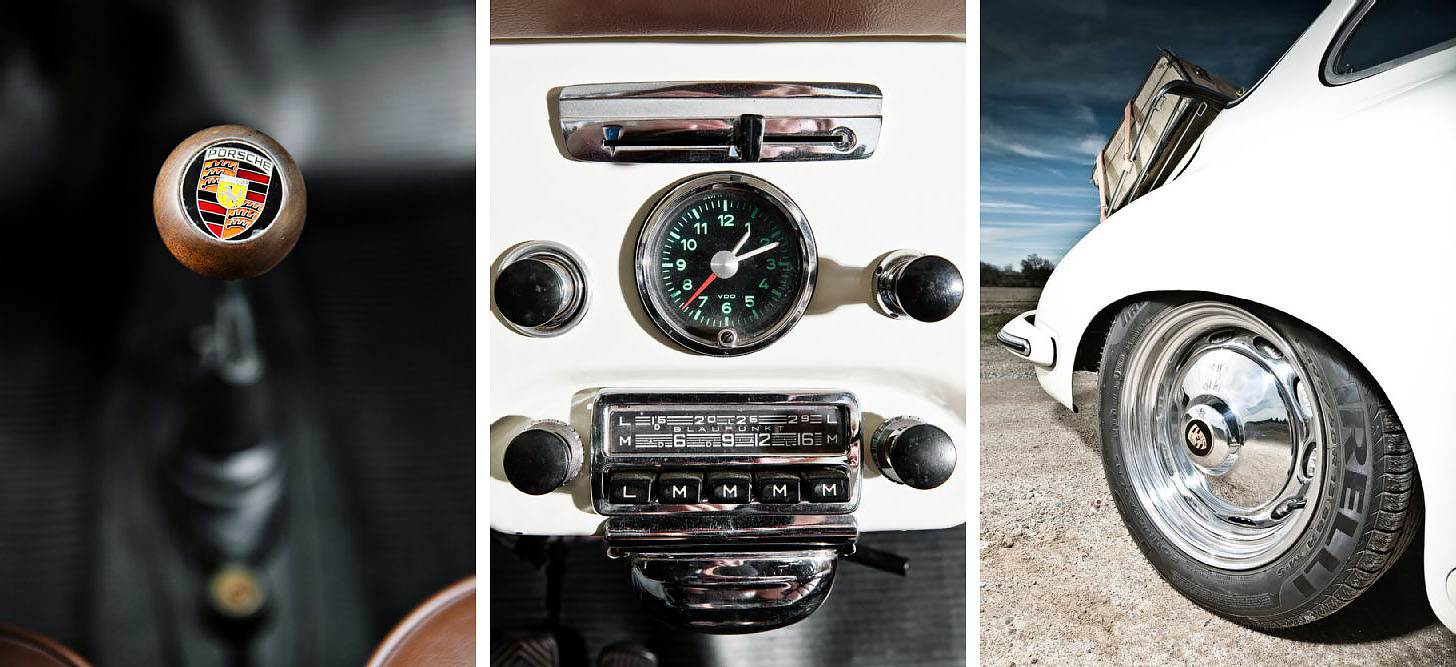
Original MW/LW radio, VDO clock and wheels with Porsche logo. Spare wheel and fuel tank occupy much of the nose. A fine quality tool kit includes a tyre pressure gauge; the mechanical jack is particularly quick and light to operate when lifting, and has instantaneous release.
In only one serious respect does the sporting side of the Porsche predominate; considerable engine noise enters the driving compartment, of a type which would certainly disturb some occupants — others, perhaps, scarcely at all. Its main source derives from the carburettor intakes, each cylinder drawing its mixture through an individual choke in one of the dual downdraught Zenith carburettors. Each carburettor is protected by a small air filter which provides little or no silencing; there appears to be plenty of space for larger air-cleaner/silencers to be fitted. Moreover, provision on the new Porsches of heating ducts to keep the rear window mist-free also entails a local reduction in sound-insulation.
No rich-mixture devices are fitted for cold starts; instead, one is instructed to depress the throttle pedal two or three times (to operate the accelerator pumps) before turning the starter key, and in very wintry weather to hold the clutch out of engagement. This works well enough and, once started, the engine is. not given to stalling, although it is obviously wise to let it warm a little before moving off. Thereafter, engine compartment temperature, acting on a thermostatic control, is made to open or close valves in heater tubes leading to each carburettor. A slight low-speed flat-spot in the test car was overcome by increasing the engine’s idling to the rather fast rate recommended by the manufacturers — 700 to 900 r.p.m.
A cranked gear lever of new-to-Porsche design sprouts from a point in the floor nearer to the driver than did its predecessor; it is also shorter (with correspondingly reduced movement) and more rigid. While the change is light and crash-proof, it demands depression of the clutch pedal to the full extent of its long travel. The clutch itself is smooth, progressive and light to operate.
Each forward gear engagement is assisted by the famous Porsche synchromesh of the self-servo baulk ring type, and the gearbox mechanism as a whole is fully in line with the high mechanical standard of the rest of the car. It has entirely suitable ratios — second, for instance, allowing a maximum of over 50 m.p.h., yet providing rapid acceleration, from, say, 10 m.p.h. in city traffic. When driving hard on the open road one must keep a watchful eye on the tachometer, since the makers’ recommendations for maximum revolutions are all-to-easily exceeded, power being maintained in strong measure right up to the limit of 5,500 r.p.m.
As an indication of this, to accelerate in third from 60 to 80 m.p.h., in the face of increasing wind and rolling resistances, takes only 2 sec longer than between 30 and 50 m.p.h., the figures being 8.9 and 6.9 sec respectively. The ability, in second gear, to reach 50 m.p.h. from 30 in only 4.3 sec allows the Super 75 to escape from most opposition. These figures seem the more remarkable when one takes account of the car’s considerable weight — just over a ton with two up, as tested.
| TEST CONDITIONS: Weather: Dry, overcast. 0-5 m.p.h. wind. | ||
| Air temperature, 44 deg. F. | ||
| Model described in The Autocar of 11 September, 1959 | ||
| STEERING: Turning circle: | ||
| Between kerbs, L, 33ft 2in; R, 32ft 10in. | ||
| Between walls, L, 34ft llin. R, 34ft 7in; | ||
| Turns of steering wheel from lock to lock, 2.2 |
There is an organ-type throttle pedal, so that one can “heel-and-toe.” Brake and clutch pedal levers are carried on low pivots, which give a more direct and natural arc of movement than the pendant type.
A traditional virtue of the Porsche is its easy running at high cruising speeds, brought about by a combination of high overall – gearing and the quietness with which the streamlined body cleaves through the air. The Super 75 can maintain a constant 100 m.p.h. with remarkably little commotion, and the transmission is quiet-running.
On the oil temperature gauge, the dial is marked with green and red quadrants to indicate a prudent limit of cruising speed if necessary. There is, of course, an engine oil cooler and, despite much hard driving on the test car, the needle never approached the red section; excessive oil temperature would result only from cruising too near maximum speed in very hot weather, or from some mechanical fault such as a slipping fan belt or wrongly timed ignition. The cooler is by-passed through a pressure relief valve when the oil is cold.
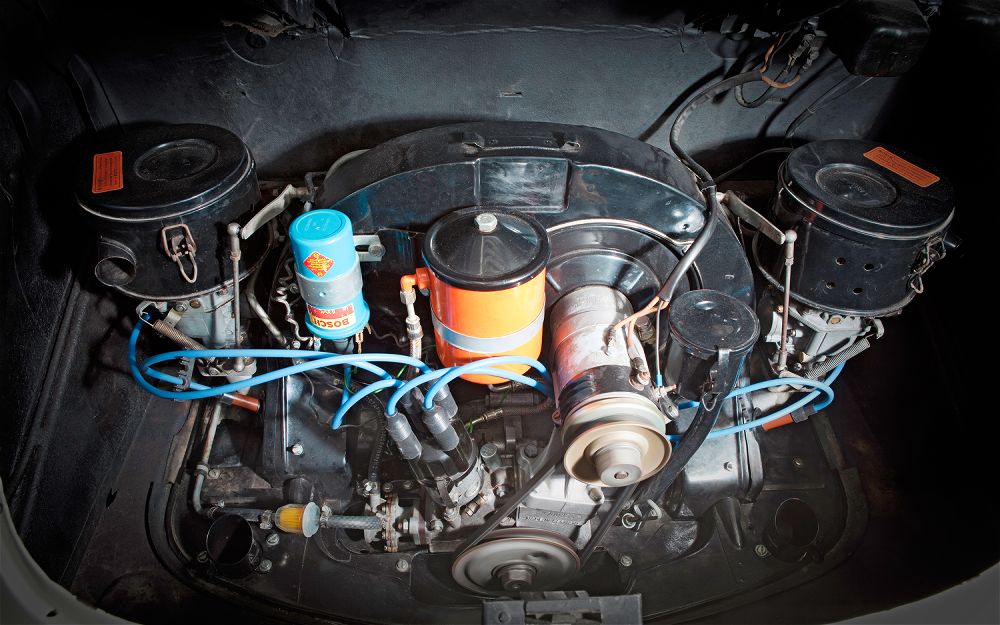
In its practically dust-proof compartment, the flat-four engine is accessible for most routine maintenance, but the sparking plugs are difficult to reach, and tappet adjustment must be tackled from beneath the car. The ducted cooling fan is attached to the forward end of the belt-driven dynamo.
For those accustomed to travelling long distances on highspeed motorways, the recorded fuel consumption of 25 m.p.g. at a constant 90 m.p.h. is well worth bearing in mind, especially since the Super 75 does not require the most expensive grades. The overall consumption of 29.2 m.p.g. for 1,114 miles included the performance testing and a number of fast journeys, as well as some city commuting. By avoiding speeds in excess of 60 m.p.h. and full-throttle acceleration, a typical journey average of 35 m.p.g. was recorded.
| Car speedometer MPH | 10 | 20 | 30 | 40 | 50 | 60 | 70 | 80 | 90 | 100 | 110 |
| True speed MPH | 10 | 18 | 28 | 39 | 50 | 59 | 68 | 73 | 81 | 90 | 100 |
Drawing from the lessons and experience of a vigorous works racing department, the Porsche designers have evolved a production private car with handling qualities which enable it to compete very successfully in rallies without modifications to standard specification. Carrying only 42 per cent of its weight (unladen) on the front wheels, and having a wheelbase of under 7ft, the Porsche naturally differs considerably in feel from cars with more orthodox layouts. It has all-independent suspension, by superimposed parallel trailing arms at the front, and by swing axles at the rear. When travelling fast the ride is soft by sports car standards; it is a little firmer at low speeds when there is sometimes a characteristic lateral rocking motion — difficult to define — suggesting rather restricted vertical wheel movements. The short wheelbase also makes the car prone to pitch on poor surfaces, noticed particularly at night when the head lamp beams lift and drop in sympathy.
| Speed range Gear Ratios and Time in Sec, | ||||
| M.p.h. | 3.61 to 1 | 5.01 to 1 | 7.82 to 1 | 13.69 to 1 |
| 10—30 | 4.9 | — | ||
| 20—40 | — | 7.8 | 4.4 | — |
| 30—50 | 10.7 | 6.9 | 4.3 | — |
| 40—60 | 11.0 | 7.3 | — | — |
| 50—70 | 11.6 | 7.9 | — | — |
| 60—80 | 12.8 | 8.9 | — | — |
| 70—90 | 14.3 | — | — | — |
| 80—100 | 21.9 | — | — | — |
Whatever the terrain, there is a wonderful sense of unity about the car’s whole structure (in which the steel body and boxed frame are welded together), with no apparent flexing or rattling of its separate components.
For really fast cornering, the absence of roll and almost uncanny individual wheel adhesion displayed by the new car combine to make it outstandingly fast and safe on winding roads. It maintains these leech-like qualities to a remarkable degree (aided by Michelin X tyres) on a damp surface, and remains both stable and predictable. It has been said that the new rear-end geometry has made this the first Porsche which could be drifted round a bend, and any oversteer tendency could pass unnoticed in normal use. Tyre squeal is almost unheard with these Michelin tyres, nor is one hindered by wheelspin on full-power starts from rest.
Very quick response 1960 Porsche 356 Super 75 and lightweight action of the steering add much to one’s pleasure and confidence when driving the car fast on cross-country journeys; road shocks are absorbed by an hydraulic steering damper. A fight touch on the wheel is all that is necessary for such sensitive control — indeed, too firm a grip is best avoided.
The test car’s engine and transmission were carried on prototype, rather flexible mountings of a new pattern which resulted in some weave at high speeds on the straight. Although calling for some concentration, this directional instability in time ceased to be a worry as one became accustomed to it. It is understood that all production cars imported into this country will have the old-pattern mountings, and a similar car with these was tried later and found to run true with much less correction.
| From rest through gears to: | |
| MPH | SEC |
| 0-30 | 3.2 |
| 0-40 | 5.6 |
| 0-50 | 7.8 |
| 0-60 | 11.4 |
| 0-70 | 15.6 |
| 0-80 | 20.6 |
| 0-90 | 28.8 |
| 0-100 | 41.7 |
| Standing quarter mile 18.1 sec. | |
Aluminium brake drums with transverse ribbing and cast steel inserts are fitted. The brakes are powerful and well balanced, and have good properties of endurance when put to hard use. On the debit side, they were some-what rough on the test car, particularly at low speeds, as though the drums were distorted. Pedal pressures are quite moderate, and reaction to pedal movement is progressive. The T-handle parking brake is able to hold the car on a 1-in-3 gradient. In addition to speedometer (with trip mileage recorder) and tachometer, there are gauges for oil temperature and fuel level, as well as the usual indicator lights. On this car the speedometer was erratic above 70 m.p.h. By night a rheostat controls the intensity of instrument lighting and, since the instruments are overhung by the padded brow above the facia, there are no reflections in the screen. A cigarette lighter is a standard fitting.
| FUEL CONSUMPTION (m.p.g. at steady speeds): | |
| m.p.h. | Top Gear |
| 30 | 50.0 |
| 40 | 44.0 |
| 50 | 38.8 |
| 60 | 35.6 |
| 70 | 32.2 |
| 80 | 29.4 |
| 90 | 25.0 |
| Overall fuel consumption for 1,114 miles | 29.2 m.p.g. (9.67 litres per 100 km) |
| Approximate normal range | 27-35 m.p.g. (10.5-8.1 litres per 100 km) |
| Fuel: | Premium grades |
The dished steering wheel has three spokes arranged in T-formation so that they do not obstruct the driver’s view of his instruments when the car is travelling straight. There is plenty of room for the thighs beneath it, and clear vision above it. Mounted on the steering column is a multi-purpose finger-tip lever to operate the direction signals, to raise or dip the head lamp beams and to flash these for signalling by night or day. Master switch for side and head lamps is a push-pull knob, rotated to regulate instrument lighting. A reversing lamp is lit with reverse selected and the head lamps dipped. The steering wheel boss is pressed to sound a single-note horn — not as effective as the ring it replaces, and in this case calling for too much pressure.
| MAXIMUM SPEEDS ON GEARS: | |||
| Gear | M.p.h. | K.p.h. | |
| Top | (mean) | 108.8 | 175.2 |
| (best) | 110.0 | 177.1 | |
| 3rd | 80 | 128.8 | |
| 2nd | 52 | 83.7 | |
| 1st | 29 | 46.7 | |
| TRACTIVE EFFORT (by Tapley meter) | |||
| |
Pull lb per ton | Equivalent gradient | |
| Top | 210 | 1 in 10.6 | |
| Third | 315 | 1 in 7.0 | |
| Second | 470 | 1 in 4.7 | |
Standard fittings include a hand throttle, which can be locked in any position, and foot-operated screen washers. The self-parking screen wipers are rather noisy. Beneath the facia is a convenient three-way fuel tap — giving, Off, Main and Reserve positions. The tank holds 11 ½ gallons, including one reserve, allowing the Porsche well over 300 miles between refills. Twelve fuses for the electrical services are also located under the facia. A typically ingenious feature is that the rear-view mirror has an eccentric mounting, and can be turned to suit short or tail drivers.
Softly padded sun visors with wire frames have been a notable Porsche feature for several years. Conforming with American requirements, the windscreen is of laminated safety glass. Both front seats have adjustable backrests, which can be made to recline fully if the seats are pulled right forward. Cushions and backrests are trimmed in a serviceable, smooth plastic, and are contoured to give real comfort and proper support against side forces. They remain entirely restful on long journeys, when the ability to change position by altering the backrest rake is of considerable value.
Although the scuttle is a little high, the steep, downward slope of the short bonnet helps to provide a good field of vision, the road being visible within a few feet of the car’s nose. On this latest model, swivelling window panes in the front doors have added to the front pillars’ effective thickness, which some habitual Porsche owners might regret. Gone now are the previous under-scuttle fresh air vents.
| BRAKES (at 30 m.p.h. in neutral): | ||
| Pedal load in lb | Retardation | Equiv. stopping distance in ft |
| 25 | 0.20g | 151 |
| 50 | 0.52g | 58 |
| 75 | 0.85g | 35.5 |
| 90 | 0.92g | 32.8 |
Interior heating, supplied from the engine cylinders, is admitted via an adjustable valve, just forward of the gear lever, and soon becomes effective after a cold start. Al-though no exhaust fumes entered the car, the atmosphere remained fresher in cold weather if one of the hinged rear quarter windows was kept open. The new demisting ducts to the back window were not very effective during short journeys, proved a great boon once they had time to clear the whole glass.
There is plenty of room for maps and the other odds and ends one carries in a car — a locker in the facia, full length pockets in the doors, little receptacles at knee level, just forward of the screen pillars — and even coat hooks. The new rear seats with folding backrests provide extra room for occasional passengers, and with these folded down the Porsche has abundant luggage space to supplement the small compartment in the nose. A particularly neat washable plastic lines the roof, and there are practical rubber mats on the floor.
Greasing requirements are quite moderate, at 1,500-mile intervals, and the owner’s handbook is unusually comprehensive, including sectioned and exploded views of engine and transmission, as well as graphs of road speed against engine speed in all gears, power output and acceleration. The fine tool kit in a plastic bag includes a dial-type tyre-pressure gauge and spare fan belt. Incidentally, Porsche owners are proud of the fact that service engineers familiar with the make can remove the engine complete in under 15 minutes. Within the sump filter gauze, incidentally, is a magnet to collect any iron and steel particles. A towing eye is attached to the front of the chassis.
This Porsche has an almost animate personality and is a car with which one could never become bored. A road express for travelling far and fast, it is built with such precision that one would expect long service without more than routine attention.
| Car | 1960 Porsche 356 Super 75 |
|
Sold Number built |
1960-1963 – |
| Construction | All-steell |
| Engine |
Capacity, 1,582 c.c. (96.5 cu. in.). Number of cylinders, 4. Bore and stroke, S2.5 x74 mm (3.25 x2.91in.). Valve gear, o.h.v., pushrods. Compression ratio, 8.5 to 1. |
| Max power | Bhp 75 net at 5,000 rpm (Bhp per ton laden, 74.1) |
| Max torque | 88lb. ft. at 3,700 rpm |
| MPH per 1,000 r.p.m. in top gear | 20.0 |
| Transmission | 4-Speed manual |
| Drive | RWD |
| Suspension: | |
| front | independent, parallel trailing arms, transverse laminated torsion bars, anti-roll bar. |
| rear | independent swing axles with compensating transverse leaf spring, transverse round-section torsion bars. |
| Steering | worm and peg |
| Brakes |
Type: Porsche drums Method of operation, hydraulic. Drum dimensions: F and R, llin. dia., 1.57in. wide. Swept area: F, 108.5 sq. in.; R, 108.5 sq. in. (214 sq. in, per ton laden). |
| Electrical System | 6-volt; 75 amper-hour battery. Head lamps, double dip; 45-40 watt bulbs. |
| Wheels | 5.60-R15in. Michelin X. Pressures (p.s.i.): F, 118.5; R, 23.0 (normal). F, 21.5: R, 25.5 (fast driving). |
| Length | (overall), 13ft 1.7in |
| Width | 5ft 5.6in |
| Height | 4ft 4.4in |
| Wheelbase | 6ft 10.7in |
| Track | F, 4ft 3.4in; R, 4ft 2.1in |
| Ground clearance | 5.9 in |
| Tank Capacity |
11.5 Imperial including 1 reserve. Oil sump, 8.8 pints, including filter. |
| Weight |
(with 5 gals fuel), 17.25 cwt (1,932 lb)
Weight distribution (per cent): F, 42.0; R, 58.0.
Laden as tested, 20.25 cwt (2,268lb)
Lb per c.c. (laden), 1.43 |
| 0-62mph | 12 sec |
| Top speed | 107 MPH |
| Mpg | 30 |
| Price new |
(basic), with Coupe body, £1,563. British purchase tax, £652 7s 6d. Total (in Great Britain), £2,215 7s 6d- Extras: Radio, £32 19s 3d (including tax). |
| Value now |
|

Scale ¼ in. to 1ft. Driving seat in central position. Cushions uncompressed.





